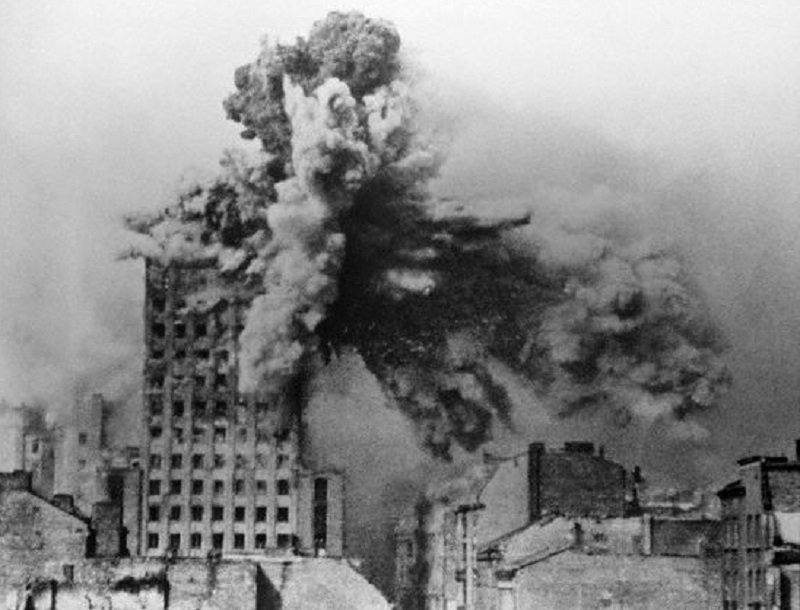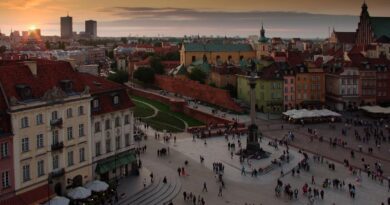Poland issues an invoice for World War II (Part 1)

In no country of conquered Europe were such murderous actions of two occupiers carried out both simultaneously and separately, especially in the form of exterminating the leaders of the occupied nation. The mass shootings of Poles in the Kampinos Forest took place at the same time the Polish officers were murdered in Katyn.
Maciej Rosalak
The largest genocidal plans of Nazi Germany were created in 1941. The successes at the war front of with the USSR were at that time perceived by them as the crowning of the conquest of all of Europe, enabling both the development of the “living space” (German: Lebensraum) in the east and the elimination of the “Jewish question” (German: Judenfrage). Both plans were based on the belief in the racial superiority of the Germans, giving them the full right to murder at least 100 million people: Slavs and Jews, for whom they harbored hatred and contempt.
The General Eastern Plan (German: Generalplan Ost) was to provide them with Lebensraum at the expense of the nations living east of the borders of the Third Reich to the Urals, and from Lake Ladoga in the north to the Black Sea in the south. All Jews, 80-85% of Poles, 50% of Czechs, 65% of Ukrainians, 75% of Belarusians and an unspecified part of Russians and Tatars were to disappear from the region (read: lose their lives at once or in Siberia).
The second plan was to exterminate all Jews, which would once and for all constitute the final solution to the “Jewish question” (German: Endlösung der Judenfrage). Mass executions of hundreds of thousands of people of Jewish origin in the conquered territories of the Soviet Union, carried out as early as in the summer of 1941, removed any doubts as to the true intentions of the Nazis. Clues indicate that the Holocaust was approved in January 1942 at the Wannsee Conference.
The Generalplan Ost was formulated six months earlier, but due to the larger scale of the project, implementation was postponed until “after the end of the war”. In our case, between 3 and 4.8 million Polish prisoners were to be left alive. The SS tried to implement this plan at the end of 1942, displacing 110,000 Polish peasants from 193 villages in the Zamość region famous for its fertile lands. Some were sent to work in Germany, others were driven to Mazovia, about 1,300 were taken to Auschwitz (1 in 5 survived), small children with “Aryan racial characteristics” were abducted to the Reich. German colonists were brought in their place. It was not until the armed countermeasures of the Polish partisans that this action was interrupted.
German approach to intelligentsia
People from Western Europe do not even realize the difference between the German presence in their territories and the double, particularly genocidal occupation that took place on Polish soil. In France, Belgium, the Netherlands, Norway, and Denmark, but also in the Czech Republic, Hungary and Romania, each had forms of their own government and armed forces, and sometimes there were volunteers for the Waffen SS units. No round-ups or mass executions were organized in these countries, and no ruthless laws were introduced, which could lead to death. Far fewer compatriots died in concentration camps, and young people were deported to perform forced labor in the Reich in significantly smaller numbers. Only in the first two transports to KL Auschwitz (1940), more than 7,500 thousand Poles were sent.

During World War II, the Germans murdered mainly those they considered to be the Polish elite. They started already during the first days of the invasion in September 1939. The slaughter of Poles was organized in cities and towns throughout Poland by mainly six murderous Einsatzgruppen SS, moving along with Wehrmacht troops in Operation Tannenberg. The Wehrmacht also killed defenseless civilians – such as in the village of Kłecko, near Gniezno – or helped the police, the SS, and the Gestapo. The Selbstschutz, consisting of local Germans and Volksdeutsche, also conducted murders.
In the second half of October 1939, Pomerania and Powiśle, Greater Poland, Silesia, northern Mazovia and Łódź were incorporated into the Third Reich. Before the war, 10 million people lived in these areas, including 9 million Poles. The Germans did not even account for 10% of the population in the region. The plunder of Polish lands was connected with the taking over by the administrative authorities of supervision over their “security”. The actions taken were rooted in the plans of the German invasion of Poland, drawn up from the moment the declaration on non-violence was signed with the Second Polish Republic in 1934. The annexation of these territories was connected with the intention of eliminating the Polish elite from them.
The effect was, among others preparation and publication by the SD (SS secret service) of “a special book of Poles who had an APB put on them” (German: Sonderfahnungsbuch Polen) by the SD (SS security service). It was a list containing over 61,000 names of Poles who were distinguished for their homeland, and therefore dangerous – according to the SS – to the Third Reich. It featured state officials, local government leaders, landowners and entrepreneurs, scientists and teachers, officers, lawyers, activists of social organizations, priests, sisters and brothers, scouts, and veterans of the struggle for a free Poland. Those who were “overlooked” were eagerly added after the German invasion, using the services of local Germans, often settling personal accounts and taking over the property of the captured Poles.
The “wanted” lists were death lists. Until April 1940, under the Intelligenzaktion, the captured were murdered (50,000, including in the forests near Piaśnica), or sent to concentration camps (another 50,000). A camp in Stutthof was built for this very purpose. They were also directed to Hohenbruch and Mauthausen-Gusen. In the vast majority of cases, this has meant death. In this way, nearly 100,000 representatives of our nation’s elite were murdered in Greater Poland, Pomerania and Silesia, as well as in Łódź and northern Mazovia. In addition to the murder of the elite, several hundred thousand Poles were then sent to forced labor camps in Germany, and by the end of 1939, almost two hundred thousand were expelled to the General Government. Their property was looted. By the end of 1940, the number of Poles expelled to the General Government exceeded a quarter of a million.
Apart from the murders during hostilities and such retaliatory executions as in Wawer, the Germans organized special actions (German: Sonderaktion) in the General Government identical to the Intelligenzaktion. These were: Sonderaktion Krakau, where, inter alia, Professors of the Jagiellonian University were arrested and sent to concentration camps, Sonderaktion Lublin, the victims of which were mainly clergymen and professors of the Catholic University of Lublin and Sonderaktion Tschenstochau, a similar operation undertaken in the city of Częstochowa. In November 1939, after the unsuccessful attempt by the carpenter Georg Elser on Hitler in Munich (with whom the Poles had absolutely no association), the Germans organized the Sonderaktion Bürgerbraukeller, during which several hundred intellectuals were arrested in the entire General Government. Any excuse is good enough it seems…
During the war and the years of occupation that followed, especially during the anti-partisan activities, about 800 Polish villages were burned down and their inhabitants shot. Terror in the cities – and especially in Warsaw – meant that people who left their homes in the morning did not know if they would come back alive in the afternoon.
10,000 Home Army soldiers died during the Warsaw Uprising, and 6,000 were considered missing (who usually also ended up dead). About 20,000 insurgents were injured – including 5,000 who suffered severe injuries. Nearly 15,000 soldiers were taken prisoner. 200,000 civilians lost their lives. Based on the recollections of my late parents, who survived the Wola massacre, the Germans gathered the Varsovians with their children in front of the tanks and burned them alive. They raped and murdered women…Nobody can count the actual number of victims of the Wola massacre – 30, 40, maybe even 50,000. People were murdered on Wolska Street in 20 different places. Some of them are: St. Lazarus Hospital – 700 murdered, Franaszek factory – 3,000, Ursus factory – 5,000, Houses of Hankiewicz – 2,000 murdered. The Germans murdered patients and doctors in hospitals, children in the orphanage, scouts, priests, and nuns. There was also no mercy for pregnant women.
(…)
This article was published in 2021 in “Do Rzeczy” magazine.



